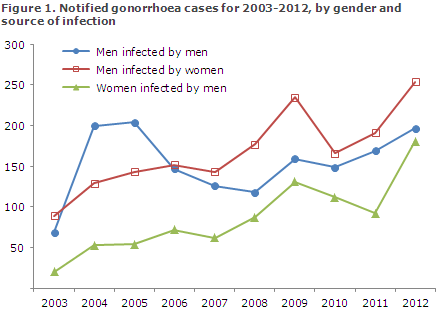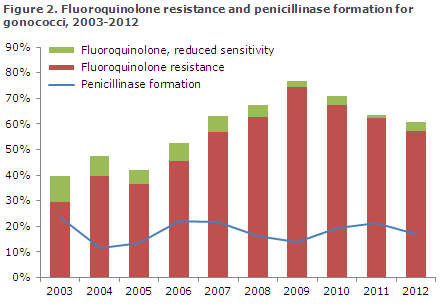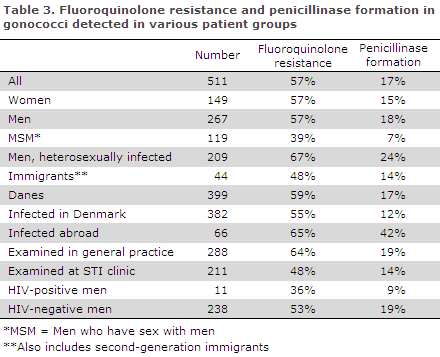No 35 - 2013
Gonorrhoea 2012
Gonorrhoea 2012
2012 saw 689 cases of gonorrhoea in 666 persons. A total of 495 (72%) were male and 194 (28 %) were female cases. The median age was 25 years for females (range: 0-61) and 29 years for males (range: 0-69), Table 1.

A total of 477 cases (69%) were detected by culture and reported to the Laboratory Notification System (LNS) and also to the Notification System for Infectious Diseases (NSID) at the Department of Infectious Disease Epidemiology. A total of 34 cases were only reported to the LNS and 178 only to the NSID.
Among the 178 cases not reported to the LNS, the diagnoses had been made by nuclear acid amplification techniques (NAAT) in 153 (86%) cases. In 2011 the diagnosis was made by NAAT in 67% of the 158 cases not reported to the LNS.
Information on origin was available for a total of 620 (93%) of the 666 persons. Hereof 545 (88%) were Danes, 43 (7%) were immigrants, 19 (3%) were second-generation immigrants and 13 (2%) were tourists. The geographical distribution is shown in Table 2.
The number of culture-confirmed gonorrhoea cases in the North Denmark Region increased in the 2007-2009 period peaking at 103 cases, EPI-NEWS 36/10. Subsequently, the number decreased and only 19 cases were observed in 2011, EPI-NEWS 36/12. In 2012 the number had once again increased to 39 (nine females and 30 males).
The increase occurred mainly among the 15-19-year-olds and 25-29-year-olds. In the youngest age group, no gonorrhoea cases were detected in 2011.

Transmission
A total of 655 cases in 636 persons were reported to the NSID. Two cases of gonococcal conjunctivitis were reported in neonates, one male and one female case.
Among the 472 cases reported in males, 254 (54%) were acquired through heterosexual infection, 197 (42%) through homosexual infection (MSM), and the mode of infection remained unknown in 21 (4%) cases. One of the latter cases was gonococcal conjunctivitis. A total of 181 cases of heterosexual infection were reported in females, Figure 1.

Among a total of 182 MSM cases in which the country of infection was stated, 174 (96%) were infected in Denmark, whereas the corresponding number was 177 (74%) among the 239 cases observed in heterosexually infected males. Among the 165 female cases for which the country of infection was known, 150 (90%) were infected in Denmark.
A total of 18 cases were acquired in Thailand; 16 in heterosexually infected males and two in males for whom the mode of infection was not stated. The second most frequent country of infection was Greenland counting nine cases; five in heterosexually infected males and four in females.
Gonorrhoea and HIV
Among the 197 MSM, a total of 23 were reported as HIV positive, including one who had two gonorrhoea episodes in 2012. Among the 254 males who stated that they had been infected through heterosexual contact, one was reported as a HIV positive. No females were reported as being HIV positive.
Antimicrobial resistance
In 2012, the reference laboratory received 511 gonococcus isolates from the Danish departments of clinical microbiology (DCMs).
The isolates were tested for fluoroquinolone and ceftriaxone susceptibility and for penicillinase production which indicates that they are highly resistant to penicillin.
Fluoroquinolone resistance was found in 57% of the isolates (62% in 2011), Figure 2, whereas 4% had a reduced sensitivity (1% in 2011).
Penicillinase production was detected in 17% (21% in 2011). Over the past years, the MIC (minimum inhibitory concentration) for ceftriaxone has followed an increasing trend, Figure 3, but no resistant strains (MIC ≥ 0.25 microgram/mL) have ever been detected.


Mode of transmission and resistance
Fluoroquinolone resistance was detected in 39% (51% in 2011) of isolates from homosexual males, whereas the corresponding number was 67% (74% in 2011) for heterosexual males and 57% (71% in 2011) for females.
Penicillinase production and resistance to fluoroquinolones occurred more frequently among Danes than among immigrants and were more frequently acquired through infection abroad than in Denmark, Table 3. These markers were also more frequent among HIV-negative males than among HIV-positive males, and more frequent among patients seen in general practice than in patients seen at STI clinics.
As part of a joint EU project, the reference laboratory tests 50-60 strains against an expanded panel of antibiotics twice a year. In 2012 it was determined that among 112 strains, 88% were sensitive to azithromycin, 89% to cefixime (an oral cephalosporin) and 100% to spectinomycin. None of the two latter are marketed in Denmark.

Treatment
Several reports from abroad have described ceftriaxone treatment failure and detection of ceftriaxone resistant strains. The most recent European guidelines from the IUSTI (International Union against Sexually Transmitted Infections) recommend 500 mg ceftriaxone i.m. and 2 mg azithromycin p.o., both given as a single dose.
Gonorrhoea should not be treated with azithromycin alone. Doses of 1 g carry a considerable risk of treatment failure and development of resistance, while 2 g doses frequently cause adverse gastrointestinal events.
The nation-wide monitoring of gonococcal antimicrobial resistance in Denmark has a high coverage, and neither documented treatment failure nor resistance to ceftriaxone has ever been reported. Until revised Danish guidelines are published, a preliminary solution may be to increase the ceftriaxone dose from 250 mg to 500 mg i. m. in all patients lacking sensitivity testing.
It is important that all treated patients attend test-of-cure (TOC). In cases with persisting symptoms, TOC may be done by culture after 3-7 days, if possible supplemented by NAAT two weeks after termination of the treatment. Asymptomatic patients should have a NAAT performed two weeks after termination of the treatment and any positives should be supplemented by culture and susceptibility testing.
In 2012 a decrease was observed in the proportion of strains with resistance to fluoroquinolones (61% compared with 71% in 2011). In patients with ano-genital infection caused by documented fluoroquinolone-sensitive gonococci, oral ciprofloxacine 500 mg may still be given.
Commentary
The overall number of reported gonorrhoea cases has increased considerably since 2010, EPI-NEWS 36/12 and 34a/11. The increase, which seems to continue into 2013, is primarily seen among the heterosexually infected individuals, males as well as females.
Both the increasing trend and the observed distribution on sex, age and mode of infection mark a contrast compared to syphilis, which seems not to be increasing and which is mainly observed in MSM. The median age of persons with gonorrhoea is 27 years, which is 11 years less than the median age of those affected by syphilis, EPI-NEWS 34/13.
The increase in the number of reported cases may be due to a real increase in gonorrhoea incidence, increased awareness among patients and/or physicians and changed diagnostic practices. Many DCMs do combined NAAT for Chlamydia trachomatis and gonococci.
The increased use of NAAT may therefore have led to the diagnosis of cases with more silent symptoms, which would not otherwise have raised suspicion of gonorrhoea. Gonococcus-positive patients diagnosed by such testing are encouraged to undergo culture and susceptibility testing.
In 153 cases, the NSID had been notified, but no isolate had been submitted to the reference laboratory. To ensure effective treatment, it is important that changes in resistance are followed continually at the national level via monitoring of the submitted isolates.
If gonococci are diagnosed by NAAT, a culture should subsequently be performed to enable susceptibility testing.
(B. Søborg, S. Cowan, Department of Infectious Disease Epidemiology), J.S. Jensen, S. Hoffmann, Microbiology and Infection Control)
Link to previous issues of EPI-NEWS
28 August 2013